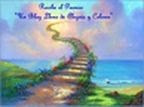Last Saturday, after breakfast with mum and a 2 hour facial treatment which put me in a most heavenly mood, I walked into a book flea mart. These sale happen quite often near my facial shop and I love them. Some of my best loved books on craft , dolls' houses (once) and India. are from these marts. I struck gold again this time when I found Kim and Chris Murray's "Illuminations From The Bhagavad-Gita".
The Bhagavad-Gita, a scared Hindu scripture has been described as one of the most important texts in the history of literature and philosophy. The Murrays have so titled this book both for the way the manuscripts are illustrated and for the illuminations one gains from reading the text.
The Gita is actually Book 6 of the Mahabharata and is written as a dialog between Lord Krishna and the hero, Arjuna, taking place in a timeless moment on the battlefield before the climactic struggle between good and evil.
Like most life changing literature, the Bhagavad Gita is told as a story. It is a story of 2 warring royal families of cousins descended from 2 brothers. The cousins were all brought up together in the same household and even had the same teachers. Alas, one family of 5 boys were endowed with knightly traits like righteousness, self-control and nobility while the other family of 100 sons embodied qualities of evil and were cruel, unscrupulous, greedy and lustful.
When it came time to crown one of them as king, war became inevitable as the eldest from the evil could not accept that the good would be crowned. Both sides sought help from Lord Krishna and so the Lord made them choose: either his vast army or Krishna himself as a charioteer and counsellor. Arjuna who was the middle child of the Good , picked the latter.
On the morning just before the battle, Prince Arjuna was torn with self doubt and remorse as he realised that his enemies were his own relatives, beloved friends and revered teachers. And so began the Bhagavad Gita (songs of God) as Lord Krishna counselled and guided Arjuna on the principles of life, love and duty in his conduct of the war.
Thanks to the universal theme, the Gita has had a significant influence far beyond Hinduism. I read that Robert Oppenheimer recited the verse (from Chapter 11) 'I [have become] Death, Destroyer of Worlds", just before the first test of the atom bomb. I have also read and re-read Chapter 11 and found no such sentence. Perhaps one of you can enlighten me?
That has always been my problem with epic literature and that's why I always love them abridged, illustrated and retold for children. I have no qualms in confessing that my copy of the Mahabharata was found at the Children's Section.
Apparently, the Gita can be found in hotel bedstands throughout India, much like a copy of the bible. Although I just checked with my sis, SuZ on MSN and she told me the only book she found in her hotel at Chennai was the in-room dining menu. I told her she can read my copy when she is back. I am always very excited when I get to share books like this with SuZ because she is even more of a visual person than me. She may also be able to identify with Arjuna being a middle child like him.
So do I recommend this book? Absolutely!
I believe this book was first printed in 1999 but my copy (a huge book) has the following details:
Artist: Kim Waters Hardbound / 80 pp Size: 16.5 x 24" Weight: 2.3 lbs ISBN: 1-886069-21-2 .
40 color plates and more than 50 black-and-white drawings,. A selection of essential verses is lavishly illustrated, incorporating both Eastern and Western classical illumination styles. The authors worked on the illustrations for over five years, inspired by the timeless wisdom of the Gita and their personal association with A.C. Bhaktivedanta Swami, the translator of the book's verses and poems from Rabinranath Tagore. Artistic inspiration from Renaissance, Pre-Raphaelite and Celtic art.















































































































































































































